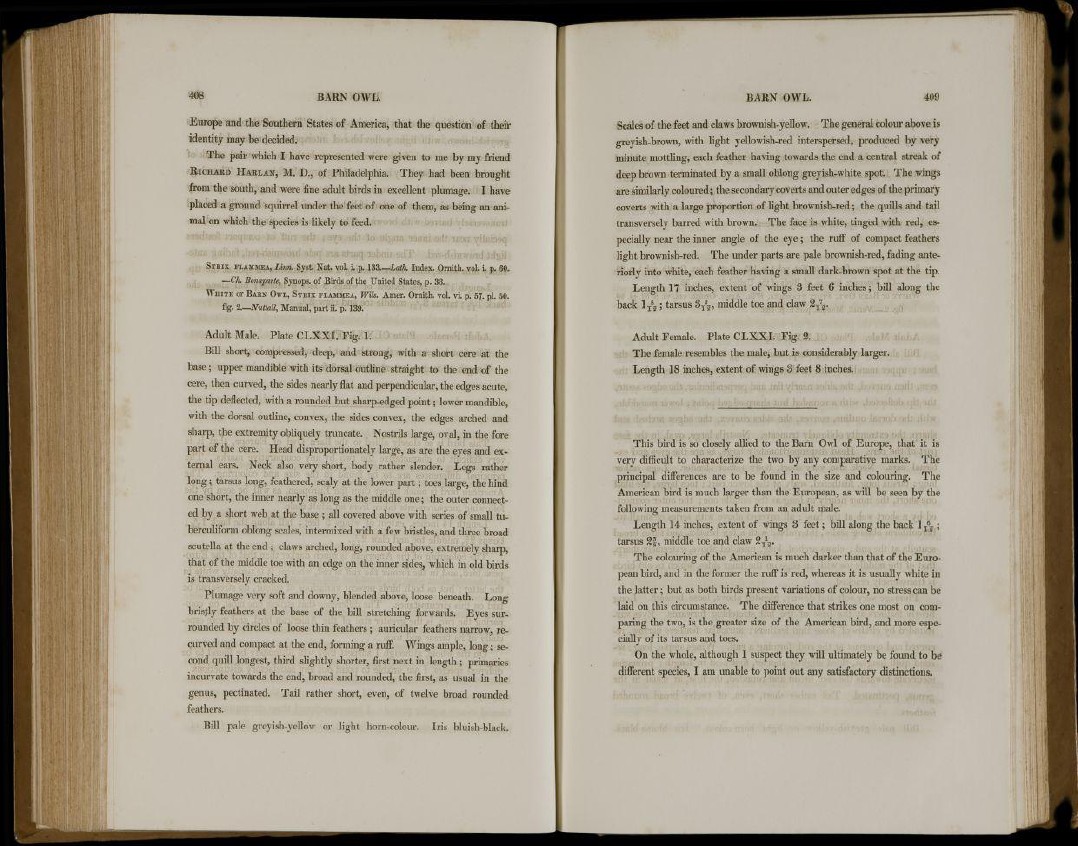
Europe and the Southern States of America, that the question of their
identity may be decided.
The pair which I have represented were given to me by my friend
RICHARD HARLAN, M. D., of Philadelphia. They had been brought
from the south, and were fine adult birds in excellent plumage. I have
placed a ground squirrel under the feet of one of them, as being an animal
on which the species is likely to feed.
STRIX FLAMMEA, Linn. Syst. Nat. vol. i. p. 133.—Lath. Index. Ornith. vol. i. p. 60.
—Ch. Bonaparte, Synops. of Birds of the United States, p. 38.
WHITE or BARN OWL, STRIX FLAMMEA, Wils. Amer. Ornith. vol. vi. p. 57. pi. 5 0 .
fig. 2—Nuttall, Manual, part ii. p. 139.
Adult Male. Plate CLXXI. Fig. 1.
Bill short, compressed, deep, and strong, with a short cere at the
base; upper mandible with its dorsal outline straight to the end of the
cere, then curved, the sides nearly flat and perpendicular, the edges acute,
the tip deflected, with a rounded but sharp-edged point; lower mandible,
with the dorsal outline, convex, the sides convex, the edges arched and
sharp, the extremity obliquely truncate. Nostrils large, oval, in the fore
part of the cere. Head disproportionately large, as are the eyes and external
ears. Neck also very short, body rather slender. Legs rather
long; tarsus long, feathered, scaly at the lower part; toes large, the hind
one short, the inner nearly as long as the middle one; the outer connected
by a short web at the base ; all covered above with series of small tuberculiform
oblong scales, intermixed with a few bristles, and three broad
scutella at the end ; claws arched, long, rounded above, extremely sharp,
that of the middle toe with an edge on the inner sides, which in old birds
is transversely cracked.
Plumage very soft and downy, blended above, loose beneath. Long
briskly feathers at the base of the bill stretching forwards. Eyes surrounded
by circles of loose thin feathers ; auricular feathers narrow, recurved
and compact at the end, forming a ruff. Wings ample, long; second
quill longest, third slightly shorter, first next in length ; primaries
incurvate towards the end, broad and rounded, the first, as usual in the
genus, pectinated. Tail rather short, even, of twelve broad rounded
feathers.
Bill pale greyish-yellow or light horn-colour. Iris bluish-black.
Scales of the feet and claws brownish-yellow. The general colour above is
greyish-brown, with light yellowish-red interspersed, produced by very
minute mottling, each feather having towards the end a central streak of
deep brown terminated by a small oblong greyish-white spot. The wings
are similarly coloured; the secondary coverts and outer edges of the primary
coverts with a large proportion of light brownish-red; the quills and tail
transversely barred with brown. The face is white, tinged with red, especially
near the inner angle of the eye; the ruff of compact feathers
light brownish-red. The under parts are pale brownish-red, fading anteriorly
into white, each feather having a small dark-brown spot at the tip.
Length 17 inches, extent of wings 3 feet 6 inches; bill along the
back l T
8 jj; tarsus 3 ft, middle toe and claw 2 ft.
Adult Female. Plate CLXXI. Fig. 2.
The female resembles the male, but is considerably larger.
Length 18 inches, extent of wings 3 feet 8 inches.
r.rr;.vu;! ef.h.troVj .eJuDnx/ii Tld0DUdo vJimoxlxo :>iU
This bird is so closely allied to the Barn Owl of Europe, that it is
very difficult to characterize the two by any comparative marks. The
principal differences are to be found in the size and colouring. The
American bird is much larger than the European, as will be seen by the
'jOOVLif.OJ} 15HJO 9.01 * 9110 J)lb<iuu "liMU. >fllil9fl T9iTJ.lI 9flJ fJlOflB 9,110
following measurements taken from an adult male.
Length 14 inches, extent of wings 3 feet; bib1 along the back 1ft ;
tarsus 2 | , middle toe and claw 2 ft.
The colouring of the American is much darker than that of the European
bird, and in the former the ruff is red, whereas it is usually white in
the latter; but as both birds present variations of colour, no stress can be
laid on this circumstance. The difference that strikes one most on comparing
the two, is the greater size of the American bird, and more especially
of its tarsus and toes.
On the whole, although I suspect they will ultimately be found to be
different species, I am unable to point out any satisfactory distinctions.